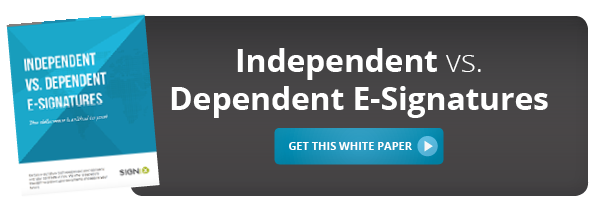
There’s always some risk involved in the insurance industry, but when it comes to e-signatures, how much are you willing to take on?
With mission-critical documents and regulatory compliance in the balance, insurance professionals would be wiser to understand exactly what they’re getting when they adopt e-signature technology.
Ready to examine your risk? PropertyCasualty360 recently published an article written by our Executive Vice President Pem Guerry that explains the critical difference between Independent E-Signatures™ and dependent e-signatures in the insurance industry.
“The digital makeup of the technology can profoundly impact the level of control, transparency, trust and longevity of an e-signature—factors that are all very important in the insurance industry. After all, you may be dealing with sensitive or financial client information, or you may ask clients to sign off on transactions that must be valid two or three decades into the future,” Pem said in the article.
Because Independent E-Signatures™ permanently embed a signature’s cryptographic information directly into a signed document, you can access the legal evidence with or without the Internet and fully independent of an e-signature vendor. But that’s not the case with dependent signatures, in which vendors link their legal evidence to a vendor’s server. If the server takes a hit or ties are severed with the vendor, you could lose all of your e-signatures’ legal evidence.
The type of e-signature you choose can greatly impact the legality and longevity of your digital documents.
If you are trying to decide which is best for you and your insurance practice, Pem said, “For mission critical transactions and when legal assurance and industry compliance are a must, independent e-signatures will be right for you. If you’re only using e-signatures for low-level, temporary transactions, a vendor dependent e-signature may be acceptable.”
Ready to dive further into the differences between independent and dependent e-signatures? We invite you to read the article in its entirety. (And if you’re more of a visual learner, this piece also includes an infographic.)
You can download them both for free by clicking below.
%20formatted-1.png?width=2528&height=739&name=SIGNiX%20Logo%20Main%20(white)%20formatted-1.png)


